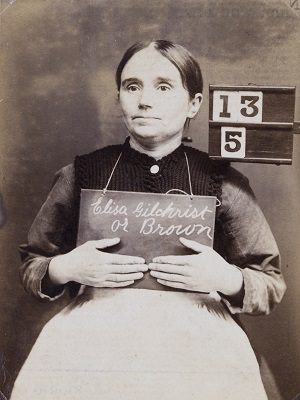
Elizabeth Gilchrist or Brown
Admitted 1868. Murder
Elizabeth was aged 21 when she killed her six month old daughter Jessie by giving her laudanum because 'the child had been troublesome and was teething and I thought the laudanum would make her sleep'. Yet moments later she added: 'I did mean to destroy her.' An alcoholic extract of opium, laudanum was readily, cheaply, and legally available in Victorian times, widely used for pain relief - and recreationally. Laudanum was administered to Elizabeth at Glasgow Royal Lunatic Asylum, where she was twice a patient, to help her sleep during manic episodes.
In common with many prisoner-patients, Elizabeth had a history of mental problems, which also ran in her family. 'Her ideas are confused and incoherent. She cannot rest and she is perfectly indifferent, impulsive and reckless about everything...Her homicidal tendencies have been often manifested. She is also suicidal and has very frequently attempted to destroy herself. Her reason is so far gone, and she has become so degenerated, that if not prevented she would eat excrement, anything, her own flesh; her fingers or toes especially...Such is her present diseased state of mind that she cannot be left unattended for a single moment either by night or by day.'
Medical men focused on sex-specific physiological events like pregnancy, childbirth and lactation, when looking for causes in women. 'Puerperal insanity' was the label applied to Elizabeth. A term used only during the 19th century, this diagnosis encompassed a wide range of symptoms, some of which might now be classed as post-partum psychosis. Prison policy was not to release puerperal maniacs until the end of their childbearing span.
Gendering could, however, work to women's advantage in eliciting sympathy. Authorities often shifted blame for wrongdoing onto menfolk, who should have behaved better. Gartnavel described her husband Robert Brown as 'a young good-for-nothing', whom she married when aged just 17 and who had recently died in Argentina 'after a short life of dissipation and vice'. He allegedly neglected her and took her out of Gartnavel before she was ready, just to save money.
In her pre-trial statement, Elizabeth recorded that since returning home from Gartnavel, 'I felt sometimes the old depression which had afflicted me come back and when in these turns I had thoughts of killing myself. I told my husband... and he did not know what to do with me... I felt my mind affected and it was in that condition that I gave the laudanum to the child.'
By the early 20th century Elizabeth had been discharged from, and readmitted to Perth Criminal Lunatic Department(CLD) multiple times; at one stage her son smuggled her to America for a fresh start, but that too ended in relapse. Deemed no longer dangerous because 'her mental condition has now permanently settled down into consecutive dementia', she was transferred to Ayrshire District Asylum at Glengall in March 1904, and died there in 1909.
Photograph of Elizabeth included in her Criminal Lunatics (Perth) records, 21 September 1889
Credit: Crown copyright, NRS, HH17/15
Medical Report into the present state of mind of Elizabeth Gilchrist or Brown by Alexander Mackintosh M.D., Physician Superintendent at Royal Asylum Gartnavel, 18th September 1867, p1
Credit: Crown copyright, NRS, AD14/67/118
Medical Report into the present state of mind of Elizabeth Gilchrist or Brown by Alexander Mackintosh M.D., Physician Superintendent at Royal Asylum Gartnavel, 18th September 1867, p2
Credit: Crown copyright, NRS, AD14/67/118
The order for Elizabeth’s conditional liberation under the guardianship of Mr George Mathie and Mrs Mary Mair, 12th January 1889
Credit: Crown copyright, NRS, HH17/15
Letter from Mary Mair, Kilmarnock, 27th January 1890 to Dr McNaughton. Mary informs the Dr that Elizabeth had gone to America with her son, but had taken ill there. Now back in Scotland, she hopes Elizabeth can return to ‘your kind care…where we know she is well looked after’, p1
Credit: NRS, HH17/15
Letter from Mary Mair, Kilmarnock, 27th January 1890 to Dr McNaughton. Mary informs the Dr that Elizabeth had gone to America with her son, but had taken ill there. Now back in Scotland, she hopes Elizabeth can return to ‘your kind care…where we know she is well looked after’, p2
Credit: NRS, HH17/15












